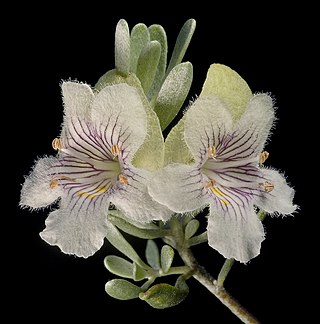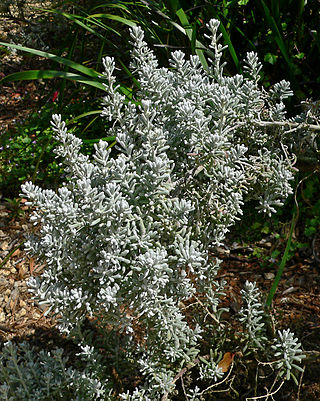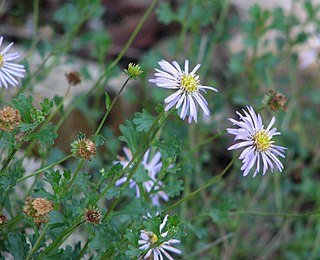
Leucopogon is a genus of about 150-160 species of shrubs or small trees in the family Ericaceae, in the section of that family formerly treated as the separate family Epacridaceae. They are native to Australia, New Zealand, New Caledonia, the western Pacific Islands and Malaysia, with the greatest species diversity in the south-west of Western Australia. Plants in this genus have leaves with a few more or less parallel veins, and tube-shaped flowers usually with a white beard inside.

Prostanthera, commonly known as mintbush or mint bush, is a genus of about 100 species of flowering plants in the mint family Lamiaceae, and all are endemic to Australia. Plants are usually shrubs, rarely trees with leaves in opposite pairs. The flowers are arranged in panicles in the leaf axils or on the ends of branchlets. The sepals are joined at the base with two lobes. The petals are usually blue to purple or white, joined in a tube with two "lips", the lower lip with three lobes and the upper lip with two lobes or notched.

Calandrinia is a genus of flowering plants known as purslanes and redmaids. It includes 37 species of annual and perennial herbs which bear colorful flowers in shades of red to purple and white. Species of this genus are native to the Americas, including western and southern South America, Central America, and western North America. Some species have been introduced to parts of Australia, New Zealand, southern Africa, Asia, and Europe. Over 60 species native to Australia and New Guinea that were formerly included in Calandrinia are now placed in a separate genus, Rumicastrum or Parakeelya. A single eastern Australian species named in 2022, Calandrinia petrophila, is still included in Calandrinia, but will be placed into the Australian genus when the name of the new genus is finally settled.

Triodia is a large genus of hummock grass endemic to Australia. The species of this genus are known by the common name spinifex, although they are not a part of the coastal genus Spinifex. Many soft-leaved Triodia species were formerly included in the genus Plectrachne. Triodia is known as tjanpi (grass) in central Australia, and have several traditional uses amongst the Aboriginal Australian peoples of the region.

Maireana is a genus of around 57 species of perennial shrubs and herbs in the family Amaranthaceae which are endemic to Australia. Species in this genus were formerly classified within the genus Kochia. The genus was described in 1840 by the botanist, Moquin-Tandon and named to honour Joseph François Maire (1780-1867), an amateur botanist who befriended him during the author's first visit to Paris in 1834.

Trachymene is a genus of herbaceous plants in the family Araliaceae. The species are native to Australia, Malesia, New Caledonia and Fiji.

Calotis is a genus of herbs or small shrubs in the daisy family Asteraceae. Most of the species are native to Australia, while two occur in Asia.

Styphelia is a genus of shrubs in the family Ericaceae, native from Indo-China through the Pacific to Australia. Most have minute or small leaves with a sharp tip, single, tube-shaped flowers arranged in leaf axils and with the ends of the petals rolled back with hairs in the inside of the tube.

Schoenus is a predominately austral genus of sedges, commonly known as bogrushes, or veldrushes in South Africa. Species of this genus occur mainly in South Africa, Australia and Southeast Asia. Others are found in scattered locations worldwide, from Europe to Asia, North Africa and the Americas. Three species occur in the peatlands of southern South America, including S. antarcticus which is found in Tierra del Fuego, where it forms a component of hyperhumid Magellanic moorland.

Camphorosmeae is a species-rich tribe of the Amaranthaceae, formerly Chenopodiaceae, with 20 genera and about 179 species. It is classified as a single tribe of subfamily Camphorosmoideae.

Rumicastrum is a genus of plants in the family Montiaceae. It includes 66 species native to Australia, Tasmania, and New Guinea. These species were formerly classed in genus Calandrinia, which was discovered to be paraphyletic.











